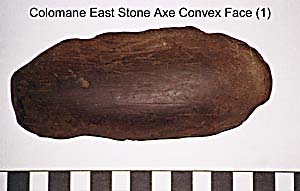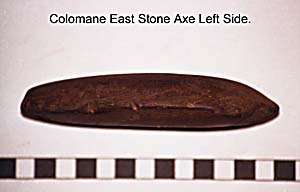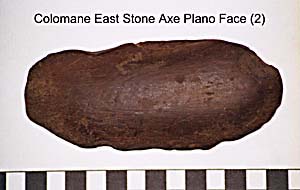 This polished stone axehead was found in August 2005, to the west of Cullomane Anomalous Stone Group, adjacent to a house built in the 1930's.
Its presence provides evidence not just for woodland clearance in the area but wood-working as well - though of course there is no evidence linking it to the nearby monuments.
This polished stone axehead was found in August 2005, to the west of Cullomane Anomalous Stone Group, adjacent to a house built in the 1930's.
Its presence provides evidence not just for woodland clearance in the area but wood-working as well - though of course there is no evidence linking it to the nearby monuments.
Now in posession of the National Museum of Ireland (NMI 2016:236), it is made from mudstone, which is a fine grained sedimentary rock commonly used for axes in the southern counties of Ireland.
 The asymmetrical blade profile means that it was more likely to have been used as an adze than an axe.
The asymmetrical blade profile means that it was more likely to have been used as an adze than an axe.
If used as an adze it would have been mounted at right angles to the handle, rather than in line with it. Both edges are notched below the butt to help retain the ties that would have been used to bind it to the handle.
 There are considerable traces of wear, not to mention the large chip out of its edge, so it has obviously been well used.
There are considerable traces of wear, not to mention the large chip out of its edge, so it has obviously been well used.
The fact that it is a stone axe does not mean that it is a neolithic artefact. There is good reason to believe that the manufacture of stone tools continued well into the late Bronze Age (O'Hare 2005). The presence of this artefact within a purely late bronze-age context must surely reinforce this view.
References
- COONEY, GABRIEL & MANDAL, STEPHEN 1998 The Irish Stone Axe Project, Monograph 1. Bray, Co. Wicklow: Wordwell.
- O'HARE, MARIA BRIGID 2005 The Bronze Age Lithics of Ireland. Paper presented at the 11th Annual Meeting of the European Association of Archaeologists, Cork.